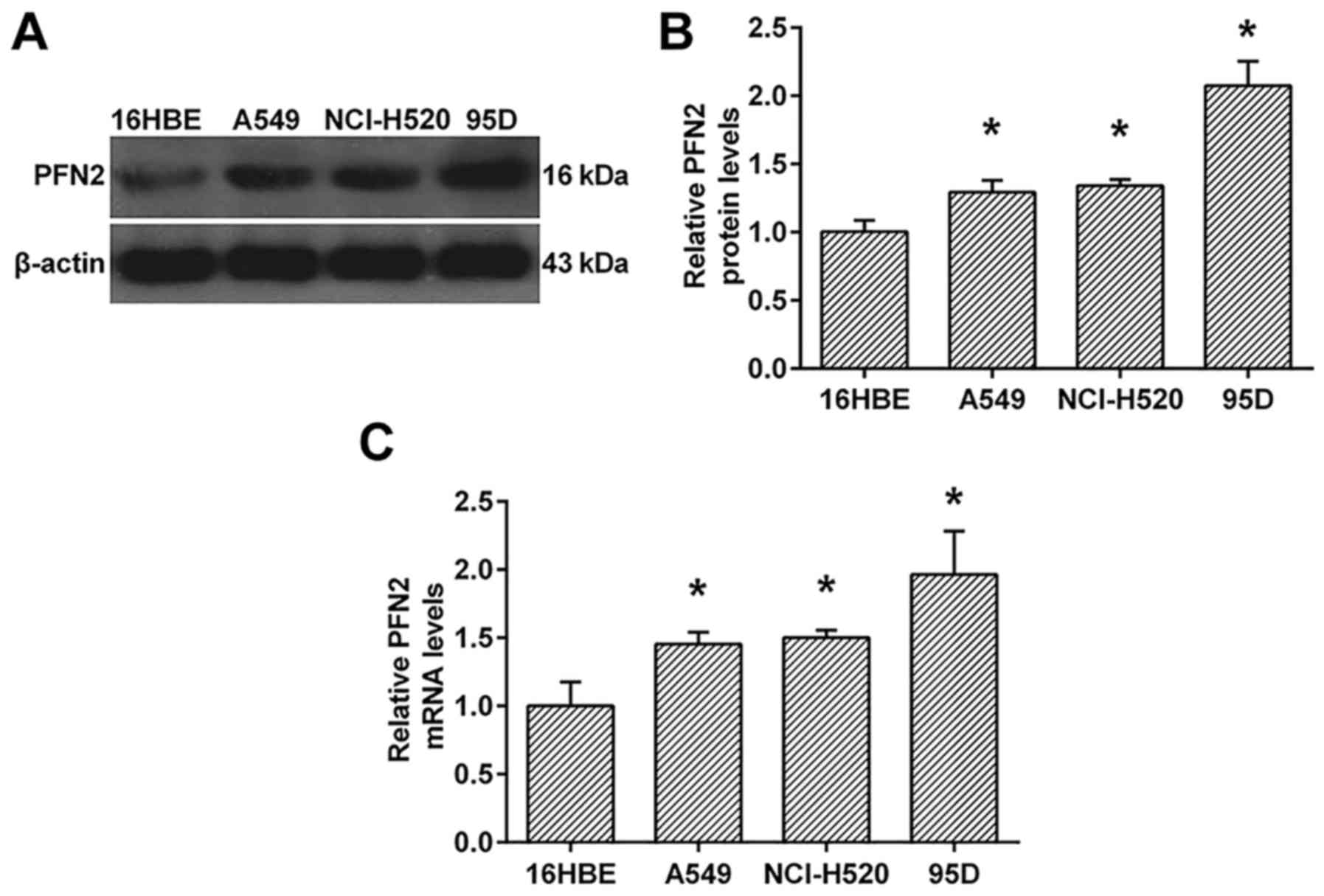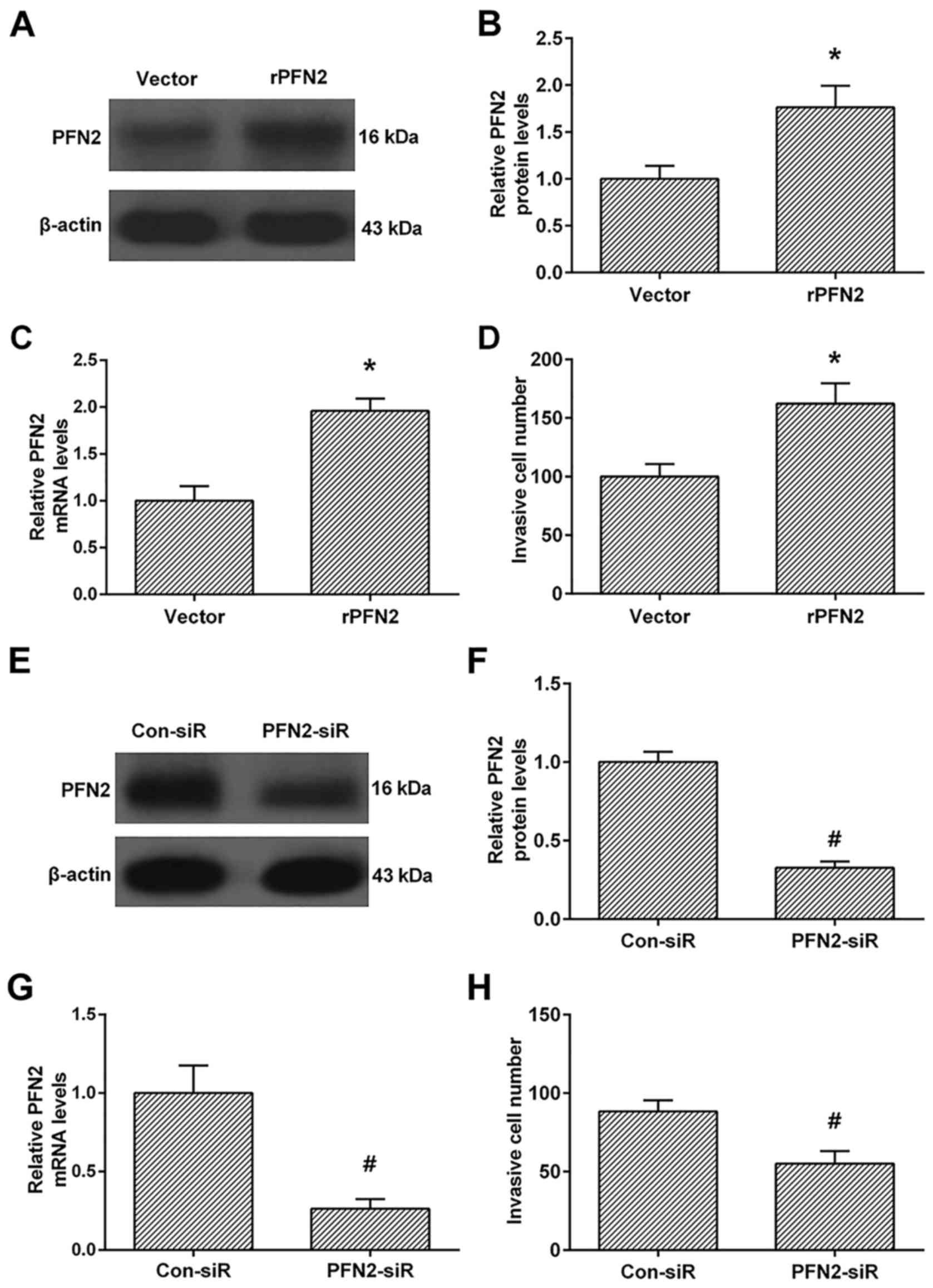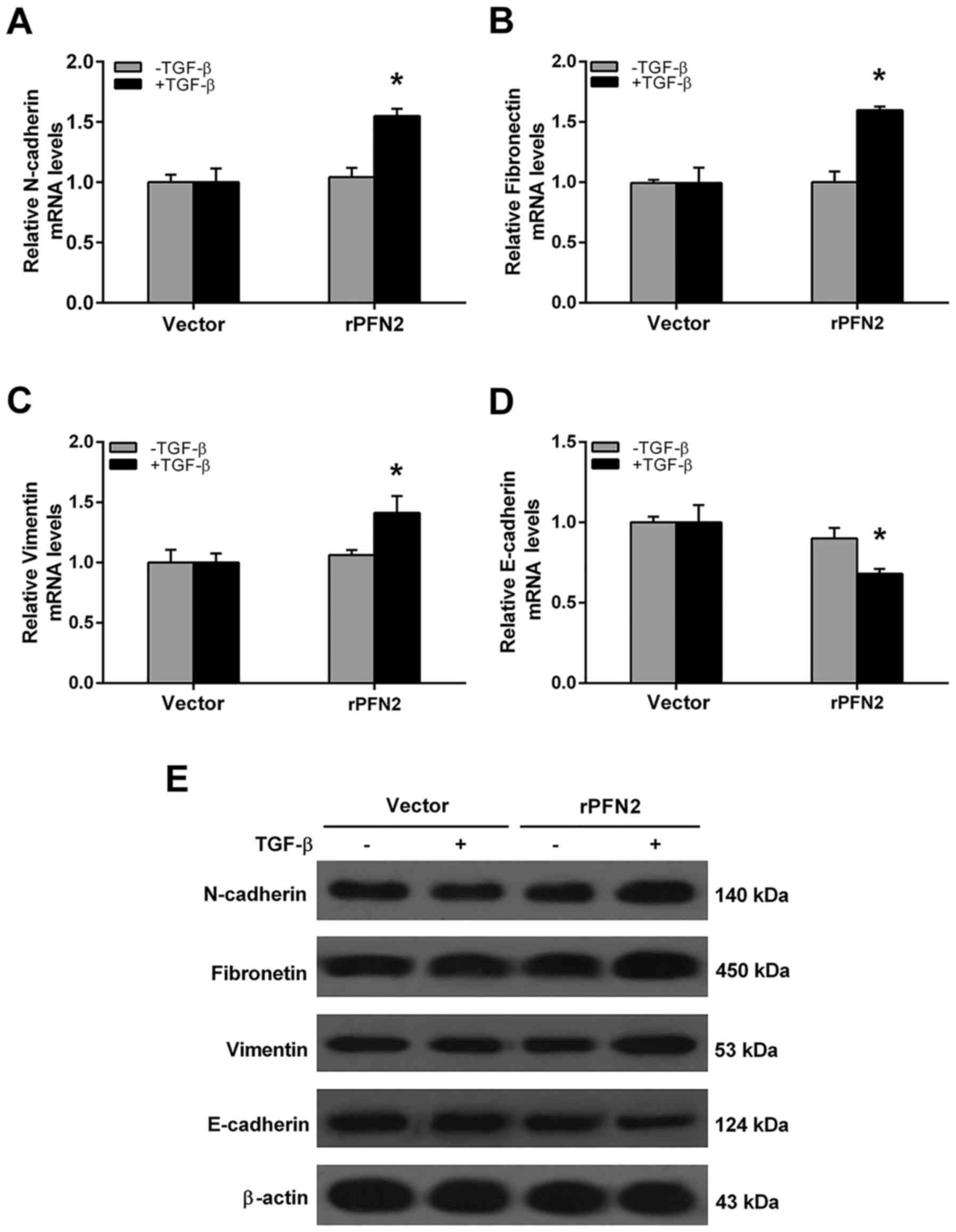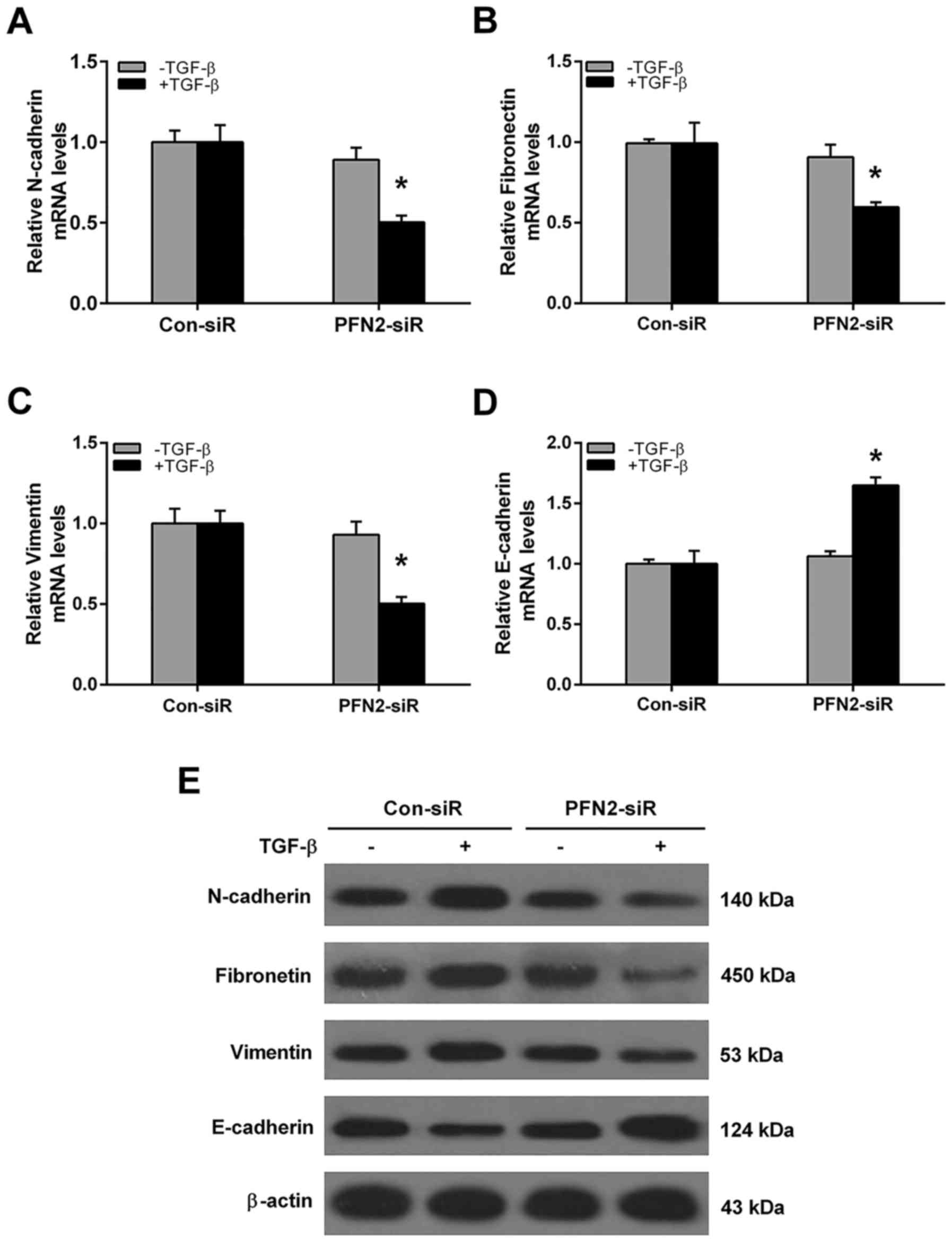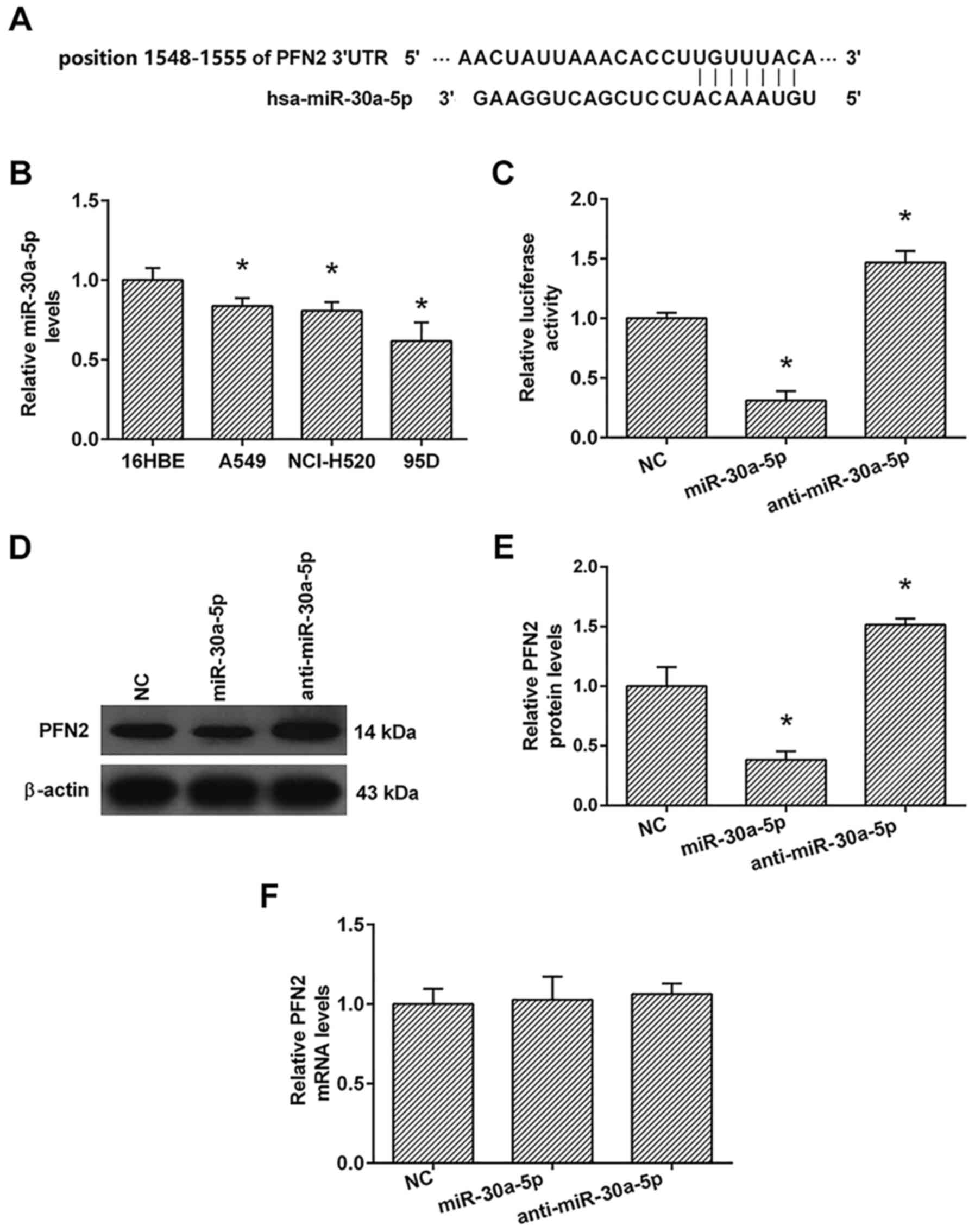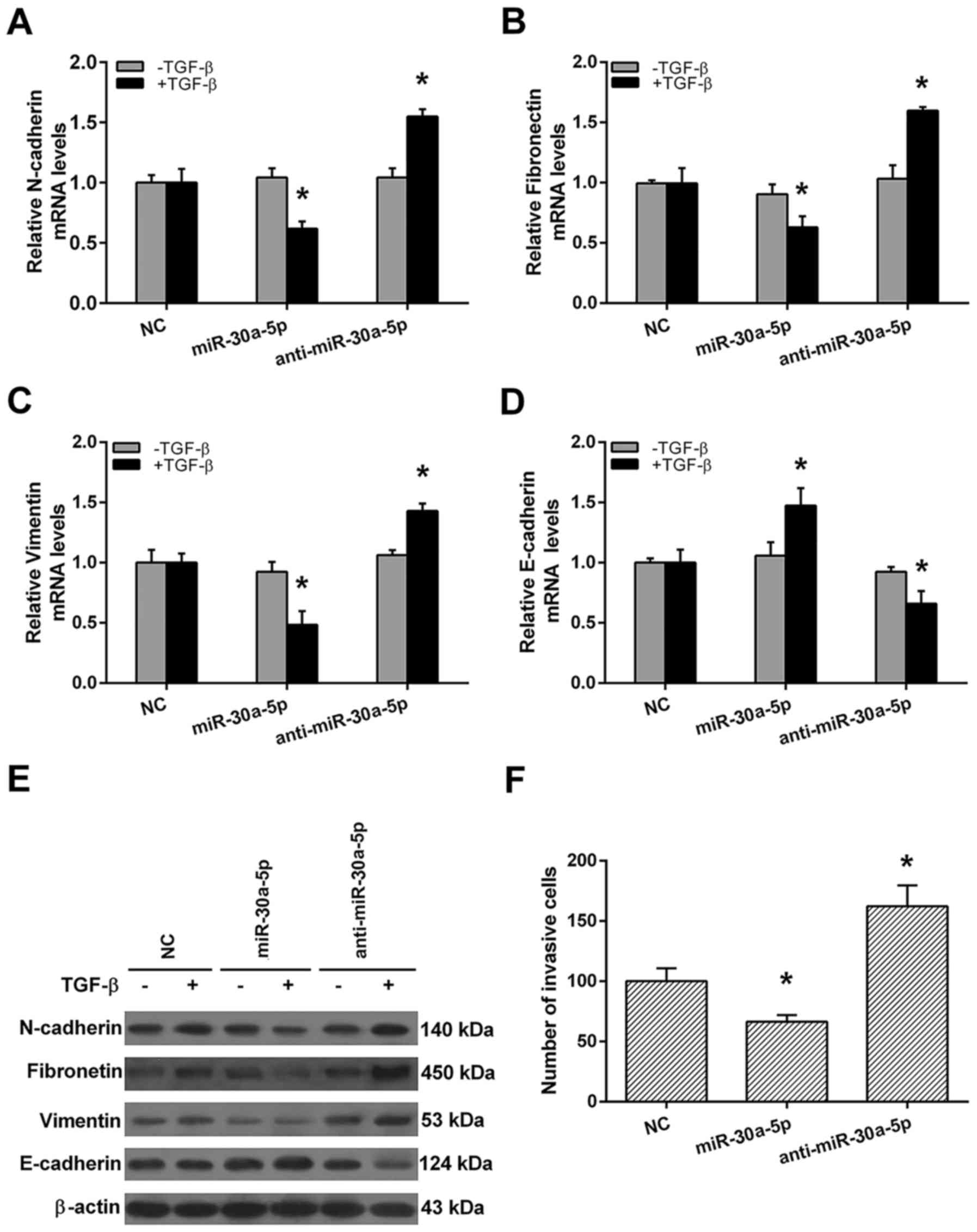MicroRNA-30a-5p suppresses epithelial-mesenchymal transition by targeting profilin-2 in high invasive non-small cell lung cancer cell lines
- Authors:
- Published online on: April 11, 2017 https://doi.org/10.3892/or.2017.5566
- Pages: 3146-3154
Abstract
Introduction
Among many types of cancer, non-small cell lung cancer (NSCLC) is associated with the highest morbidity and is the most common cause of cancer-related deaths worldwide (1). Clinical data have demonstrated that almost 80% of lung cancers are NSCLC with a considerably low survival rate (5-year survival rate <15%) (2,3). Despite the recent improvements in chemotherapy and molecular-targeted therapy, patients with advanced NSCLC still have poor prognoses (4–6). Therefore, the challenge in the treatment of NSCLC is to identify novel targets that can repress the invasiveness and metastasis of lung cancer cells.
Epithelial-mesenchymal transition (EMT) is a complex trans-differentiation process in which epithelial cells lose junctional adhesion and adopt a mesenchymal phenotype and morphology. During the EMT process, neoplastic cells detach from the primary epithelial tumor site, invade through the basement membrane into the circulation, thereby contributing to the metastatic potential increment and cancer progression (7,8).
Profilins (PFNs) are small proteins (12–15 kDa) found in eukaryotes and identified as a protein directly interacting with actin, acidic phospholipids and several proteins which are key roles of different signaling pathways. The first isoforms of the PFN family are PFN1 and PFN2 which were discovered several years ago. There is increasing evidence in recent years to support the role of PFN2 in increasing tumor progression. Kim et al showed that PFN2 promotes migration, invasion, and stemness of HT29 human colorectal cancer stem cells (9). Cui et al demonstrated that PFN2 promotes tumor progression and metastasis in esophageal squamous cell carcinoma (ESCC) (10).
MicroRNAs (miRNAs) are small endogenous non-coding interfering RNA molecules. miRNAs often occur abnormal expression in human tumors (11) and act as essential modulators for cell proliferation, cell invasion and EMT (12). miR-30a-5p was previously reported to be frequently downregulated in various human tumors including hepatocellular carcinoma (13), non-melanoma skin cancer (14), and lung cancer (15,16). It has been reported that miR-30a-5p suppresses cell growth, cell proliferation, whereas induces cell apoptosis in hepatocellular carcinoma (12,17) and breast cancer (18). These results suggested that miR-30a-5p acts as a tumor suppressor and may serve as a therapeutic target for tumor patients. miR-30a-5p can exert its function by binding to the 3′-untranslated region (3′-UTR) of target gene mRNA and leading to mRNA cleavage or translational repression (19). Xiong et al reported that ubiquitin protein ligase E3C (UBE3C) was a direct target of miR-30a-5p in breast cancer cells and the expression of miR-30a-5p was highly negatively correlated with UBE3C (18). He et al demonstrated astrocyte elevated gene 1 (AEG-1) was a direct target of miR-30a-5p in hepatocellular carcinoma cells (17).
In the present study, we used the Target Scan database predicted that there was a binding site for miR-30a-5p in the 3′-UTR of PFN2 mRNA, along with the inverse function of PFN2 and miR-30a-5p in NSCLC development and progression as showed in previous reports. We predicted that PFN2 might be a potential target for miR-30a-5p in NSCLC. Also, the aim of the present study was to analyze the association of PFN2 and miR-30a-5p expression in NSCLC progression.
Materials and methods
Cell lines and cell culture
The human bronchial epithelial cell 16HBE and human NSCLC cell lines A549, NcI-H520 and 95D were purchased from American Type Culture Collection (ATCC, Manassas, VA, USA). Cells were cultured in RPMI-1640 supplemented with 10% fetal bovine serum (FBS) and 1% streptomycin at 37°C in a humidified 5% CO2 incubator. Cells were maintained in the medium and passaged 2–3 days.
Construction of expression vectors and cell transfection
Total RNA from cells were isolated using TRIzol reagent (Invitrogen, Carlsbad, CA, USA), and treated with RNase-free DNase (Takara, Dalian, China). Then the RNA molecules were converted to cDNA using the PrimeScript® RT reagent kit (Takara) with oligo-dT primers, according to the manufacturer's protocol. The open reading frame of human PFN2 cDNA were cloned and inserted into the pcDNA3.1 vector (Invitrogen) to construct the recombinant pcDNA3.1-PFN2 expression vector. The pcDNA3.1 vector transfected cells were also prepared. Transient transfection was performed using the FuGENE HD transfection reagent (Roche, Indianapolis, IN, USA) according to the manufacturer's instructions, and overexpression was confirmed by western blotting using the anti-Flag antibody.
siRNA transfection
PFN2 siRNA and control siRNA were purchased from Cell Signaling (Beverly, MA, USA). The protocol of siRNA transfection was performed according to the manufacturer's instructions. Briefly, 5×104 cells were seeded in each cell of 24-well micro-plates, grown for 24 h to reach 30–50% confluence, and then incubated with a mixture of siRNA and Lipofectamine 2000 reagent (Invitrogen) in 100 µl of serum-free OPTI-MEM according to the manufacturer's instructions. The transfection efficiency was examined by real-time PCR and western blotting.
Real-time quantitative PCR
Total RNA containing small RNA was extracted from cell lines using the mirVana miRNA isolation kit (Ambion, Austin, TX, USA) according to the manufacturer's protocol. The expression of miRNA was determined using the miRNA qPCR detection kit (Gene Copoeia, USA) and the mRNA of different genes were amplified using a SYBR® Premix Ex Taq™ II kit (Takara) and gene-specific primers. Real-time quantitative RT-PCR was performed in a Rotor-Gene RG-3000 Real-Time Thermal Cycler (Corbett Research, Australia). All reactions were performed in triplicate, and the relative expression levels for miRNA and mRNAs were normalized using the 2−∆∆CT method (20) relative to small nuclear RNA U6 (U6 snRNA) and β-actin, respectively.
Western blotting
The RIPA lysis buffer (Beyotime, Nantong, China) was used to extract proteins from cultured cells. The antibodies are as follows: anti-PFN2 (1:1,000) anti-β-actin (1:500), HRP-conjugated secondary (1:500) antibodies (KangChen Bio-tech, Shanghai, China). ECL reagent (Beyotime) was used for detection. The luminescence was scanned using a Typhoon scanner (Amersham Biosciences, Piscataway, NJ, USA), and the protein band density was quantified using the Quantity One software (version 4.2.2, Bio-Rad Laboratories, Hercules, CA, USA), and the results were normalized according to β-actin.
Enforced expression and knockdown of miR-30a-5p
The miR-30a-5p mimics, negative control miRNA (control miRNA) and anti-miR-30a-5p inhibitor (anti-miR-30a-5p) were transfected into 95D cells, using Lipofectamine 2000 (Invitrogen) at a final concentration of 15 or 30 nM. The cells were then harvested for analysis 24 h post-transfection.
Cell invasion assay
Cell invasion was evaluated using a Transwell chamber assay (Costar, Pleasanta, CA, USA) according to the manufacturer's protocol. Serum-free DMEM was added to the upper chambers and DMEM containing 10% fetal calf serum was added to the lower chambers. Cells were cultured for 48 h and transferred to the upper chambers (1×105 cells per Transwell). After 24 h of incubation, cells that had migrated to the lower surface were fixed in 90% alcohol and stained with 0.08% crystal violet.
Luciferase reporter assay
A pmirGLO Dual-Luciferase miRNA target expression vector was used for 3′-UTR luciferase assays (Promega, Madison, WI, USA). For the luciferase reporter assays, cells cotransfected with negative control, hsa-miR-30a-5p mimics, or anti-hsa-miR-30a-5p and PFN2 expression vectors using Lipofectamine 2000. At 18 h post-transfection, cells were assayed using luciferase assay kits (Promega) according to the manufacturer's protocol. The results were normalized with Renilla luciferase.
Statistical analysis
The SPSS version 19.0 software (SPSS, Chicago, IL, USA) was used to analyze the related data with χ2 test or t-test. A value of P<0.05 was considered statistically significant.
Results
PFN2 is upregulated in NSCLC cell lines
To investigate the probably role of PFN2 in NSCLC, we investigate the protein and mRNA levels of PFN2 in NSCLC cell lines, A549, NcI-H520 and 95D. As shown in Fig. 1, the protein and mRNA levels of PFN2 were all upregulated in NSCLC cell lines when compared to human bronchial epithelial cell line, 16HBE (Fig. 1). Moreover, the expression of PFN2 in 95D cells was higher than those in A549 and NcI-H520 cells (Fig. 1).
PFN2 enhances invasive ability in high invasive NSCLC cell line
We then investigated the role of PFN2 in the invasive ability in high invasive NSCLC cell line 95D after PFN2 upregulation. As shown in Fig. 2A-C, the protein and mRNA levels of PFN2 were significantly upregulated in PFN2-transfected cells than vecter-transfected cells (Fig. 2A-C). These results confirmed that PFN2 overexpressing cells were successfully established. We then investigated the invasive ability between the vector and PFN2-transfected cells. The Transwell analysis revealed that PFN2-transfection enhanced cell invasion when compared to the vector-transfection group (Fig. 2D). Moreover, we also knocked down the PFN2 levels by PFN2 specific siRNA (Fig. 2E-G), and demonstrated that PFN2-siRNA inhibits cell invasion compared to the control group (Fig. 2H).
PFN2 promotes TGF-β-induced EMT in high invasive NSCLC cell line
We evaluated the mRNA levels of EMT markers in 95D cells treated with TGF-β to investigate the effect of PFN2 on EMT phenomenon. In the vector group, the mRNA levels of N-cadherin, fibronectin, vimentin and E-cadherin were all similar with or without TGF-β treatment (Fig. 3A-D). However, after TGF-β stimulation, PFN2 transfected-95D cells displayed increased mesenchymal cell marker N-cadherin, fibronectin, vimentin and reduced epithelial marker E-cadherin expressions when compared with the vector group (Fig. 3A-D). Moreover, the protein expression levels of EMT markers were also evaluated by western blot analysis. As shown in Fig. 3E, under TGF-β treatment, PFN2 transfected-95D cells possess higher N-cadherin, fibronectin, vimentin but lower E-cadherin protein levels compared to the vector group. Conversely, the mRNA and protein levels of EMT markers were also evaluated after PFN2-siR treatment. As shown in Fig. 4, without TGF-β treatment, the mRNA and protein levels of N-cadherin, fibronectin, vimentin and E-cadherin were all similar between control siRNA and PFN2-siRNA group. However, the PFN2 siRNA cells displayed reduced mesenchymal cell marker N-cadherin, fibronectin, vimentin and increased epithelial marker E-cadherin expressions when compared to the control siRNA group under TGF-β stimulation (Fig. 4). These results suggested that PFN2 positively regulated TGF-β-induced EMT in NSCLC cells.
Inverse correlation between PFN2 and miR-30a-5p expression levels
To identify candidate miRNAs that can control 95D cell invasion and EMT by modulating PFN2 expression, we used the Target Scan database (http://www.targetscan.org) to search for miRNA binding sites in the PFN2 3′-UTR and predicted that the position 1548–1555 of 3′UTR of PFN2 was a binding site for miR-30a-5p (Fig. 5A). Furthermore, we detected the expression of miR-30a-5p in 16HBE, A549, NcI-H520 and 95D cells using the real-time PCR analysis. As shown in Fig. 5B, the expression of miR-30a-5p in A549, NcI-H520 and 95D cells were lower than those in 16HBE cells.
To confirm whether miR-30a-5p directly targets the 3′-UTR of PFN2 mRNA, we employed vectors encoding a partial sequence of the 3′UTR of PFN2 mRNA where the predicted miR-30a-5p target sites were located. We found that the luciferase activity was significantly increased by co-transfection with anti-miR-30a-5p and the vector carrying the 3′UTR of PFN2 compared with the negative control. On the contrary, co-transfection with the miR-30a-5p mimics and the vector carrying the 3′UTR of PFN2 obviously decreased the luciferase activity (Fig. 5C). These results showed that miR-30a-5p bound directly to a specific site in the 3′UTR of PFN2 mRNA.
To confirm the role of miR-30a-5p in the regulation of PFN2 expression, real-time PCR and western blot analyses were also performed. The real-time PCR analysis showed that the transfection with miR-30a-5p had no significant effect on the mRNA levels of PFN2 compared to the negative control (Fig. 5F). The results of western blotting showed that anti-miR-30a-5p significantly increased the protein levels of PFN2, whereas miR-30a-5p transfection markedly inhibited the protein levels of PFN2 compared to the negative control (Fig. 5D and E).
miR-30a-5p attenuates invasion and TGF-β-induces EMT in high invasive NSCLC cell lines
EMT is an initiator of metastasis in cancers. To investigate whether miR-30a-5p is required for TGF-β-induced EMT in high invasive NSCL cell line, qRT-PCR and western blot analyses were performed after miR-30a-5p or anti-miR-30a-5p transfection. As shown in Fig. 6, without TGF-β treatment, the mRNA and protein levels of N-cadherin, fibronectin, vimentin and E-cadherin were all similar among negative control (NC), miR-30a-5p mimics and anti-miR-30a-5p groups (Fig. 6A-E). With TGF-β treatment, miR-30a-5p mimics group displayed reduced mesenchymal cell marker N-cadherin, fibronectin, vimentin and increased epithelial marker E-cadherin expressions when compared with NC group. Otherwise, anti-miR-30a-5p group displayed increased mesenchymal cell marker N-cadherin, fibronectin, vimentin and reduced epithelial marker E-cadherin expressions when compared with NC group (Fig. 6A-E). Finally, we demonstrated that miR-30a-5p mimics group possessed weaker, whereas the anti-miR-30a-5p group possessed stranger invasive ability in 95D cells when compared to NC group (Fig. 6F). These results indicate that miR-30a-5p may act as a positive regulator of cell invasion in high invasive NSCLC cells.
Discussion
PFN2 is an actin-binding protein that regulates the dynamics of actin polymerization and plays a key role in cell motility (10). Previous evidence suggests that PFN2 has crucial roles in conferring the invasive potential of several human cancers such as colorectal cancers (9), esophageal squamous cell carcinoma (10) and even lung cancer. For example, Kim et al found that PFN2 promotes migration and invasion in human colorectal cancer stem cells, and directly regulated the expression of stemness markers (CD133, SOX2, and β-catenin) and EMT markers (E-cadherin and snail) (9). Cui et al demonstrated that PFN2 protein was overexpressed in ESCC and was positively correlated with invasion depth and lymph node metastasis, further experiment proved that PFN2 promotes invasion and migration, as well as induces an EMT phenotype in ESCC cells in vitro (10). Tang et al reported that PFN2 upregulates Smad2 and Smad3 expressions via an epigenetic mechanism, and that PFN2 and Smad expression correlate with lung cancer growth and metastasis (2). However, the potential contributions of the PFN2 gene to the EMT phenotypes and invasion in high invasive NSCLC cells required further investigation.
The present study confirmed that the expression of PFN2 was higher in three NSCLC cell lines (lung adenocarcinoma cell line A549, lung squamous cell carcinoma cell line NCI-H520 and large cell lung cancer cell line 95D) when compared to the bronchial epithelial cell 16HBE. Interestingly, the high invasive cell line 95D possesses the highest PFN2 level among the three NSCLC cell lines. These results suggested that PFN2 may be involved in the metastatic process of NSCLC. Then the gain-of-function (overexpression) and loss-of-function (siRNA) experiments showed that PFN2 promotes cell invasion in high invasive NSCLC cells.
EMT occurs during embryonic development and cancer metastasis and results in enhanced cell invasion. Further experiments in our study demonstrated that PFN2 enhanced the mRNA and protein levels of N-cadherin, fibronectin and vimentin, whereas inhibited these levels of E-cadherin, which supports a role for PFN2 as a critical regulator of EMT induction in NSCLC cells. Therefore, our data provide new evidence to demonstrate that PFN2 has a pivotal role in conferring the EMT potential of NSCLC cells.
Different miRNAs were shown to play an important role in the regulation of tumor properties in NSCLC. Multiple tumor-suppressive miRNAs were downregulated coordinately in NSCLC cells and tissues, namely, miR-15a/16, miR-34a, miR-126 miR-128 (21), mir-375, mir-133a, mir-33a (22), and miR-187-5p (23). MicroRNA-30a has been identified as a tumor suppressor in NSCLC. For example, miR-30a is downregulated in NSCLC, and it inhibits EMT progression by targeting Snai1 (24). Overexpression of miR-30a in A549 cell line inhibits migration and invasion via targeting EYA2 (25).
In this study, we found that miR-30a-5p significantly inhibited EMT and cell invasion in NSCLC cells, which supports the role of miR-30a-5p as a tumor suppressor in NSCLC. Importantly, we also found that PFN2 was a direct target of miR-30a-5p in NSCLC cells; miR-30a-5p decreased PFN2 protein but not mRNA levels, suggesting that miR-30a-5p induces translational repression of PFN2. Subsequently studies confirmed that increased miR-30a-5p levels in NSCLC cells coincided with decreased EMT and cell invasion, whereas decrease in miR-30a-5p levels caused increased in EMT and cell invasion. To our knowledge this is the first study analyzing the association of PFN2 and miR-30a-5p expression with NSCLC progression.
In conclusion, our results provide important evidence that miR-30a-5p can directly target PFN2, and suggest that the association of miR-30a-5p and PFN2 may play a role in the development of NSCLC by modulating EMT and cell invasion. Therefore, miR-30a-5p activation or PFN2 inhibition may provide a novel strategy for the treatment of NSCLC.
References
|
Siegel R, Naishadham D and Jemal A: Cancer statistics, 2013. CA Cancer J Clin. 63:11–30. 2013. View Article : Google Scholar : PubMed/NCBI | |
|
Tang YN, Ding WQ, Guo XJ, Yuan XW, Wang DM and Song JG: Epigenetic regulation of Smad2 and Smad3 by profilin-2 promotes lung cancer growth and metastasis. Nat Commun. 6:82302015. View Article : Google Scholar : PubMed/NCBI | |
|
Valenzuela-Iglesias A, Sharma VP, Beaty BT, Ding Z, Gutierrez-Millan LE, Roy P, Condeelis JS and Bravo-Cordero JJ: Profilin1 regulates invadopodium maturation in human breast cancer cells. Eur J Cell Biol. 94:78–89. 2015. View Article : Google Scholar : PubMed/NCBI | |
|
Coumans JVF, Gau D, Poljak A, Wasinger V, Roy P and Moens PDJ: Profilin-1 overexpression in MDA-MB-231 breast cancer cells is associated with alterations in proteomics biomarkers of cell proliferation, survival, and motility as revealed by global proteomics analyses. OMICS. 18:778–791. 2014. View Article : Google Scholar : PubMed/NCBI | |
|
Boyl Pilo P, Di Nardo A, Mulle C, Sassoè-Pognetto M, Panzanelli P, Mele A, Kneussel M, Costantini V, Perlas E, Massimi M, et al: Profilin2 contributes to synaptic vesicle exocytosis, neuronal excitability, and novelty-seeking behavior. EMBO J. 26:2991–3002. 2007. View Article : Google Scholar : PubMed/NCBI | |
|
Yue B, Sun B, Liu C, Zhao S, Zhang D, Yu F and Yan D: Long non-coding RNA Fer-1-like protein 4 suppresses oncogenesis and exhibits prognostic value by associating with miR-106a-5p in colon cancer. Cancer Sci. 106:1323–1332. 2015. View Article : Google Scholar : PubMed/NCBI | |
|
Singh A and Settleman J: EMT, cancer stem cells and drug resistance: An emerging axis of evil in the war on cancer. Oncogene. 29:4741–4751. 2010. View Article : Google Scholar : PubMed/NCBI | |
|
Yao D, Dai C and Peng S: Mechanism of the mesenchymal-epithelial transition and its relationship with metastatic tumor formation. Mol Cancer Res. 9:1608–1620. 2011. View Article : Google Scholar : PubMed/NCBI | |
|
Kim MJ, Lee YS, Han GY, Lee HN, Ahn C and Kim CW: Profilin 2 promotes migration, invasion, and stemness of HT29 human colorectal cancer stem cells. Biosci Biotechnol Biochem. 79:1438–1446. 2015. View Article : Google Scholar : PubMed/NCBI | |
|
Cui XB, Zhang SM, Xu YX, Dang HW, Liu CX, Wang LH, Yang L, Hu JM, Liang WH, Jiang JF, et al: PFN2, a novel marker of unfavorable prognosis, is a potential therapeutic target involved in esophageal squamous cell carcinoma. J Transl Med. 14:1372016. View Article : Google Scholar : PubMed/NCBI | |
|
Li W, Liu C, Zhao C, Zhai L and Lv S: Downregulation of β3 integrin by miR-30a-5p modulates cell adhesion and invasion by interrupting Erk/Ets-1 network in triple-negative breast cancer. Int J Oncol. 48:1155–1164. 2016.PubMed/NCBI | |
|
Li WF, Dai H, Ou Q, Zuo GQ and Liu CA: Overexpression of microRNA-30a-5p inhibits liver cancer cell proliferation and induces apoptosis by targeting MTDH/PTEN/AKT pathway. Tumour Biol. 37:5885–5895. 2016. View Article : Google Scholar : PubMed/NCBI | |
|
Oksuz Z, Serin MS, Kaplan E, Dogen A, Tezcan S, Aslan G, Emekdas G, Sezgin O, Altintas E and Tiftik EN: Serum microRNAs; miR-30c-5p, miR-223-3p, miR-302c-3p and miR-17-5p could be used as novel non-invasive biomarkers for HCV-positive cirrhosis and hepatocellular carcinoma. Mol Biol Rep. 42:713–720. 2015. View Article : Google Scholar : PubMed/NCBI | |
|
Balci S, Ayaz L, Gorur A, Yaroglu Yildirim H, Akbayir S, Dogruer Unal N, Bulut B, Tursen U and Tamer L: microRNA profiling for early detection of non-melanoma skin cancer. Clin Exp Dermatol. 41:346–351. 2016. View Article : Google Scholar : PubMed/NCBI | |
|
Xie K, Wang C, Qin N, Yang J, Zhu M, Dai J, Jin G, Shen H, Ma H and Hu Z: Genetic variants in regulatory regions of microRNAs are associated with lung cancer risk. Oncotarget. 7:47966–47974. 2016.PubMed/NCBI | |
|
Zhu J, Zeng Y, Xu C, Qin H, Lei Z, Shen D, Liu Z and Huang JA: Expression profile analysis of microRNAs and downregulated miR-486-5p and miR-30a-5p in non-small cell lung cancer. Oncol Rep. 34:1779–1786. 2015.PubMed/NCBI | |
|
He R, Yang L, Lin X, Chen X, Lin X, Wei F, Liang X, Luo Y, Wu Y, Gan T, et al: MiR-30a-5p suppresses cell growth and enhances apoptosis of hepatocellular carcinoma cells via targeting AEG-1. Int J Clin Exp Pathol. 8:15632–15641. 2015.PubMed/NCBI | |
|
Xiong J, Wei B, Ye Q and Liu W: MiR-30a-5p/UBE3C axis regulates breast cancer cell proliferation and migration. Biochem Biophys Res Commun. Mar 18–2016.(Epub ahead of print). doi: 10.1016/j.bbrc.2016.03.069. View Article : Google Scholar | |
|
Calin GA and Croce CM: MicroRNA signatures in human cancers. Nat Rev Cancer. 6:857–866. 2006. View Article : Google Scholar : PubMed/NCBI | |
|
Schmittgen TD and Livak KJ: Analyzing real-time PCR data by the comparative C(T) method. Nat Protoc. 3:1101–1108. 2008. View Article : Google Scholar : PubMed/NCBI | |
|
Tafsiri E, Darbouy M, Shadmehr MB, Cho WC and Karimipoor M: Abberent expression of oncogenic and tumor-suppressive microRNAs and their target genes in human adenocarcinoma alveolar basal epithelial cells. J Cancer Res Ther. 12:395–400. 2016. View Article : Google Scholar : PubMed/NCBI | |
|
Pastorkova Z, Skarda J and Andel J: The role of microRNA in metastatic processes of non-small cell lung carcinoma. Biomed Pap Med Fac Univ Palacky Olomouc Czech Repub. 160:343–357. 2016.PubMed/NCBI | |
|
Mao M, Wu Z and Chen J: MicroRNA-187-5p suppresses cancer cell progression in non-small cell lung cancer (NSCLC) through down-regulation of CYP1B1. Biochem Biophys Res Commun. 478:649–655. 2016. View Article : Google Scholar : PubMed/NCBI | |
|
Kumarswamy R, Mudduluru G, Ceppi P, Muppala S, Kozlowski M, Niklinski J, Papotti M and Allgayer H: MicroRNA-30a inhibits epithelial-to-mesenchymal transition by targeting Snai1 and is downregulated in non-small cell lung cancer. Int J Cancer. 130:2044–2053. 2012. View Article : Google Scholar : PubMed/NCBI | |
|
Yuan Y, Zheng S, Li Q, Xiang X, Gao T, Ran P, Sun L, Huang Q, Xie F, Du J, et al: Overexpression of miR-30a in lung adenocarcinoma A549 cell line inhibits migration and invasion via targeting EYA2. Acta Biochim Biophys Sin (Shanghai). 48:220–228. 2016. View Article : Google Scholar : PubMed/NCBI |



